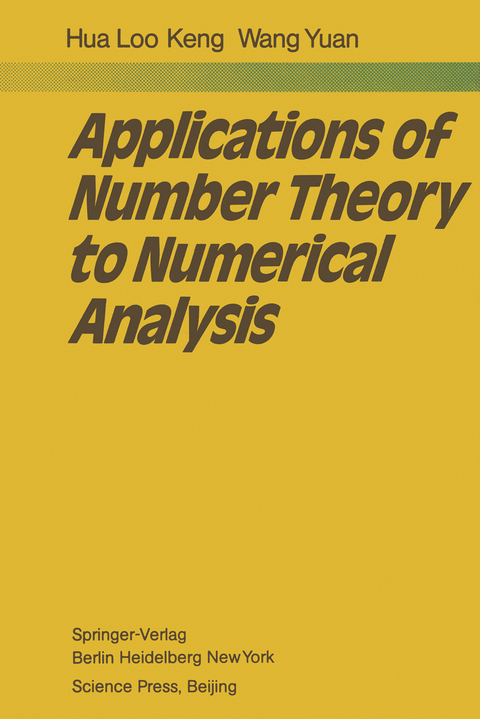
Applications of Number Theory to Numerical Analysis
Springer Berlin (Verlag)
978-3-642-67831-8 (ISBN)
1. Algebraic Number Fields and Rational Approximation.-
1.1. The units of algebraic number fields.-
1.2. The simultaneous Biophantine approximation of an integral basis.-
1.3. The real eyelotomie field.-
1.4. The units of a eyelotomie field.-
1.5. Continuation.-
1.6. The Drriehlet field.-
1.7. The cubic field.- Notes.- 2. Recurrence Relations and Rational Approximation.-
2.1. The recurrence formula for the elementary symmetric fonction.-
2.2. The generalization of Sn.-
2.3. PV numbers.-
2.4. The roots of the equation F(x) = 0.-
2.5. The roots of the equation G(x) = 0.-
2.6. The roots of the equation E(x) = 0.-
2.7. The irreducibility of a polynomial.-
2.8. The rational approximations of ?, ?, ?.- Notes.- 3. Uniform Distribution.-
3.1. Uniform distribution.-
3.2. Vinogradov's lemma.-
3.3. The exponential sum and the discrepancy.-
3.4. The number of solutions to the congruence.-
3.5. The solutions of the congruence and the discrepancy.-
3.6. The partial summation formula.-
3.7. The comparison of discrepancies.-
3.8. Eational approximation and the solutions of the congruence.-
3.9. The rational approximation and the discrepancy.-
3.10. The lower estimate of discrepancy.- Notes.- 4. Estimation of Discrepancy.-
4.1. The set of equi-distribution.-
4.2. The Halton theorem.-
4.3. The p set.-
4.4. The gp set.-
4.5. The eonstruetion of good points.-
4.6. The ?s set.-
4.7. The ? set.-
4.8. The ease s = 2.-
4.9. The glp set.- Notes.- 5. Uniform Distribution and Numerical Integration.-
5.1. The function of bounded variation.-
5.2. Uniform distribution and numerical integration.-
5.3. The lower estimation for the error term of quadrature formula.-
5.4. The quadrature formulas.- Notes.- 6. PeriodicFunctions.-
6.1. The classes of functions.-
6.2. Several lemmas.-
6.3. The relations between Hs?(C), Qs?(C) and Es?(C).-
6.4. Periodic functions.-
6.5. Continuation.- Notes.- 7. Numerical Integration of Periodic Functions.-
7.1. The set of equi-distribution and numerical integration.-
7.2. The p set and numerical integration.-
7.3. The gp set and numerical integration.-
7.4. The lower estimation of the error term for the quadrature formula.-
7.5. The solutions of congruences and numerical integration.-
7.6. The glp set and numerical integration.-
7.7. The Sarygin theorem.-
7.8. The mean error of the quadrature formula.-
7.9. Continuation.- Notes.- 8. Numerical Error for Quadrature Formula.-
8.1. The numerical error.-
8.2. The comparison of good points.-
8.3. The computation of the ? set.-
8.4. The computation of the ?s set.-
8.5. Examples of other F s sets.-
8.6. The computation of a glp set.-
8.7. Several remarks.-
8.8. Tables.-
8.9. Some examples.- Notes.- 9. Interpolation.-
9.1. Introduction.-
9.2. The set of equi-distribution and interpolation.-
9.3. Several lemmas.-
9.4. The approximate formula of the function of E?s(C).-
9.5. The approximate formula of the function of Q?s(C).-
9.6. The Bernoulli polynomial and the approximate polynomial.-
9.7. The ? results.- Notes.- 10. Approximate Solution of Integral Equations and Differential Equations.-
10.1. Several lemmas.-
10.2. The approximate solution of the Fredholm integral equation of second type.-
10.3. The approximate solution of the Volterra integral equation of second type.-
10.4. The eigenvalue and eigenfunction of the Fredholm equation.-
10.5. The Cauehy problem of the partial differential equation of the parabolic type.-
10.6. The Diriehlet problem of the partial differential equation of the elliptic type.-
10.7. Several remarks.- Notes.- Appendix Tables.
| Erscheint lt. Verlag | 15.11.2011 |
|---|---|
| Zusatzinfo | X, 244 p. |
| Verlagsort | Berlin |
| Sprache | englisch |
| Maße | 170 x 244 mm |
| Gewicht | 454 g |
| Themenwelt | Informatik ► Weitere Themen ► Hardware |
| Mathematik / Informatik ► Mathematik ► Analysis | |
| Mathematik / Informatik ► Mathematik ► Arithmetik / Zahlentheorie | |
| Mathematik / Informatik ► Mathematik ► Wahrscheinlichkeit / Kombinatorik | |
| Schlagworte | Applications • Calculus • Computer • Number Theory • Numerical analysis • Numerische Mathematik • Zahlentheorie |
| ISBN-10 | 3-642-67831-9 / 3642678319 |
| ISBN-13 | 978-3-642-67831-8 / 9783642678318 |
| Zustand | Neuware |
| Haben Sie eine Frage zum Produkt? |
aus dem Bereich


